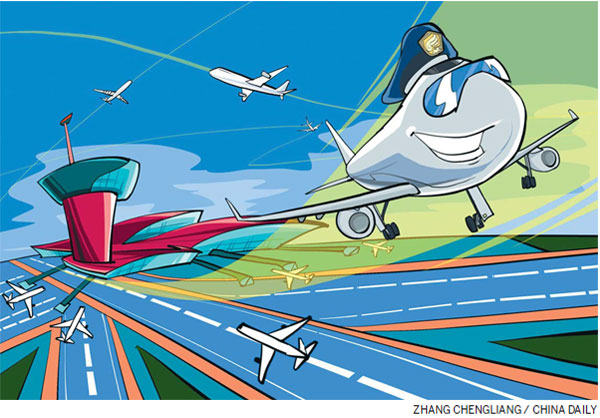Airports take off as economic centers
Updated: 2015-02-06 07:39
By John D. Kasarda(China Daily Europe)
|
|||||||||||
But increasing number of Chinese cities sinking in airport construction debt
Today's major airports have moved beyond 20th century centers of mass transit to also become 21st century strategic business infrastructure. In the process, they are attracting nearly all commercial activities traditionally found in metropolitan downtowns.
This has transformed many from what were once "city airports" into urban economic entities in their own right - airport cities. Becoming powerful business magnets, some airport areas now rival metropolitan centers in industry mix and regional economic dominance.

International airports are particularly vital to globally oriented, time-sensitive firms - those high-value businesses that depend on fast and efficient long-distance transport of everything and everyone from smartphones, biomeds, and sushi-grade tuna to corporate executives, investment bankers and professional sales staff. Airports are also essential to cities and provinces seeking to modernize their economies, boost exports and draw foreign tourists.
China's leaders understand this. The country's central, provincial and municipal governments are aggressively constructing, expanding and upgrading airports to compete globally and attract business while improving aeronautical efficiencies and passenger experiences. According to the Civil Aviation Administration of China and aeronautical consulting firm Avia-Tek, at least 85 civil airports either will be formally planned, newly constructed, or substantially expanded from 2015 to 2020.
Approximately 280 billion yuan ($44.8 billion) is being invested in China's civil airports annually. At this rate, it can be expected that about 1.5 trillion yuan will be spent on the country's airport development during the next five years. Such investments will range from 250 million yuan for Huizhou Airport in Guangdong province to 80 billion yuan for the Beijing Capital Second Airport at Daxing.
Airports are being built on an artificial island in Dalian, Liaoning province, and flattened mountaintops in Hechi, the Guangxi Zhuang autonomous region, and Shennongjia, Hubei province, and in the far reaches of the Inner Mongolia and Tibet autonomous regions. In many cases, new airport projects receive considerable funding from the central government. In others, municipalities are taking on the financial burden of airport construction, typically accruing huge debt in the process.

There is growing concern that an increasing number of China's municipalities are getting in over their heads with airport debt. Critics also argue that an airport construction "bubble" is being created through overinvestment and that some proposed airports are simply not needed.
Critics are right to an extent and the central government is aware of these concerns. CAAC statistics show that nearly three-quarters of China's civil airports lose money and that upwards of 90 percent of smaller regional airports operate at a loss.
These statistics tell only part of the story, however. If not placed in a broader cost-benefit context, they can create apprehensions, which can potentially derail otherwise rational airport investment initiatives.
While it is certainly best for airport accounting balance sheets to show annual revenues at least meeting operating expenditures, this is not the true measure of net benefit of airport investment and ongoing expenditures. Airports, in addition to being enterprises, are valuable public infrastructures that bring considerable benefits to people and businesses in the regions they serve, as well as to the country as a whole.
At the macro level, there is the economic stimulus effect of airport (and other infrastructure) investment that China has used effectively to counter slowdowns in the private sector, creating new jobs, business revenues and, ultimately, additional taxes.
For example, Zhengzhou's new Terminal 2 and its connected multimodal ground traffic center, both currently under construction, are employing nearly 20,000 workers in shifts on a 24/7 basis. When Shanghai Hongqiao built its second runway and new Terminal 2 along with its adjoining 15 billion yuan rail station, similar numbers were employed.

The impact of airports on business development is typically much greater. Soon after investments to expand Zhengzhou International Airport were announced and its 5-sq-km bonded zone created, Foxconn located a manufacturing campus there that employs 240,000 workers assembling Apple's iPhones and other digital devices. Smartphone output from this campus doubled the value of Henan province exports between 2011 and 2012 and has turned Zhengzhou International Airport into China's fastest growing in cargo volumes for each of the past three years.
Building on this success, the 415 sq km Zhengzhou Airport Economy Zone was established by the State Council in March 2013 to serve as a modern aerotropolis, the name for an airport-centered economic subregion. According to the zone's administrative committee director Zhang Yanming, an additional 14 smartphone manufacturers and suppliers have established bases in the zone, making it the world's largest site for smartphone production. Across all business sectors, 48 major projects in the Zhengzhou Airport zone were signed in the past two years with a total investment value exceeding 150 billion yuan.
It is probably unrealistic to think that more than a handful of second- and third-tier municipalities will experience the scale of airport-linked business development that is taking place in Zhengzhou. Even if they are much smaller, though, these broader economic benefits (as well as social benefits that better air connectivity brings) should be considered in the airport investment decision, along with the forecast of annual airport operating costs and revenues.
Still troublesome is the heavy debt burdens many municipalities are amassing to construct airports where significant central government subsidies are not available. It is therefore encouraging to see that the State Council is developing policies permitting private-sector investment in municipal airports through public-private partnerships.
It is similarly encouraging that China's governments at all levels are fostering aerotropolis development around airports through favorable land-supply policies, bonded and free trade zones, tax incentives, and surface transportation infrastructure provision. Resulting business investment will not only boost municipal and provincial economies, but also generate additional passengers and cargo for airports, thereby improving their longer-term financial viability.
The author directs the Center for Air Commerce at the University of North Carolina's Kenan-Flagler Business School and serves as chief adviser to the Administrative Committee of the Zhengzhou Airport Economy Zone. The views do not necessarily reflect those of China Daily.
(China Daily European Weekly 02/06/2015 page10)
Today's Top News
Chinese FM eyes 'harvest' for ties with Slovakia
Russia leads UN initiative to target IS
New Greek govt lobbies across Europe for solution to its debt
Birmingham plans to transform city into global financial hub
China: Norway violates rights of Chinese scholar
Italy extradites suspect in theft
A great future for UK-China business relationship
Former IMF chief Strauss-Kahn on trial over pimping charges
Hot Topics
Lunar probe , China growth forecasts, Emission rules get tougher, China seen through 'colored lens', International board,
Editor's Picks

|

|

|

|

|

|





